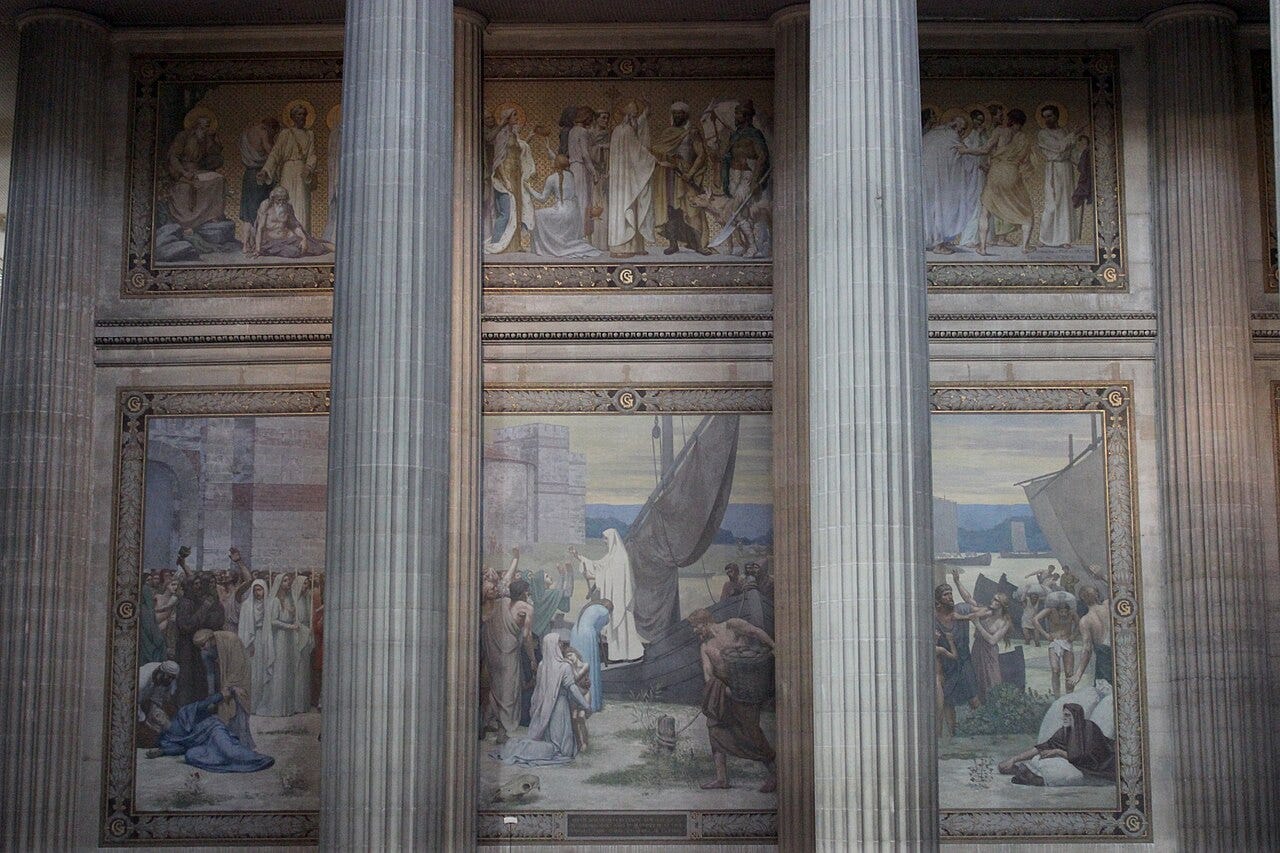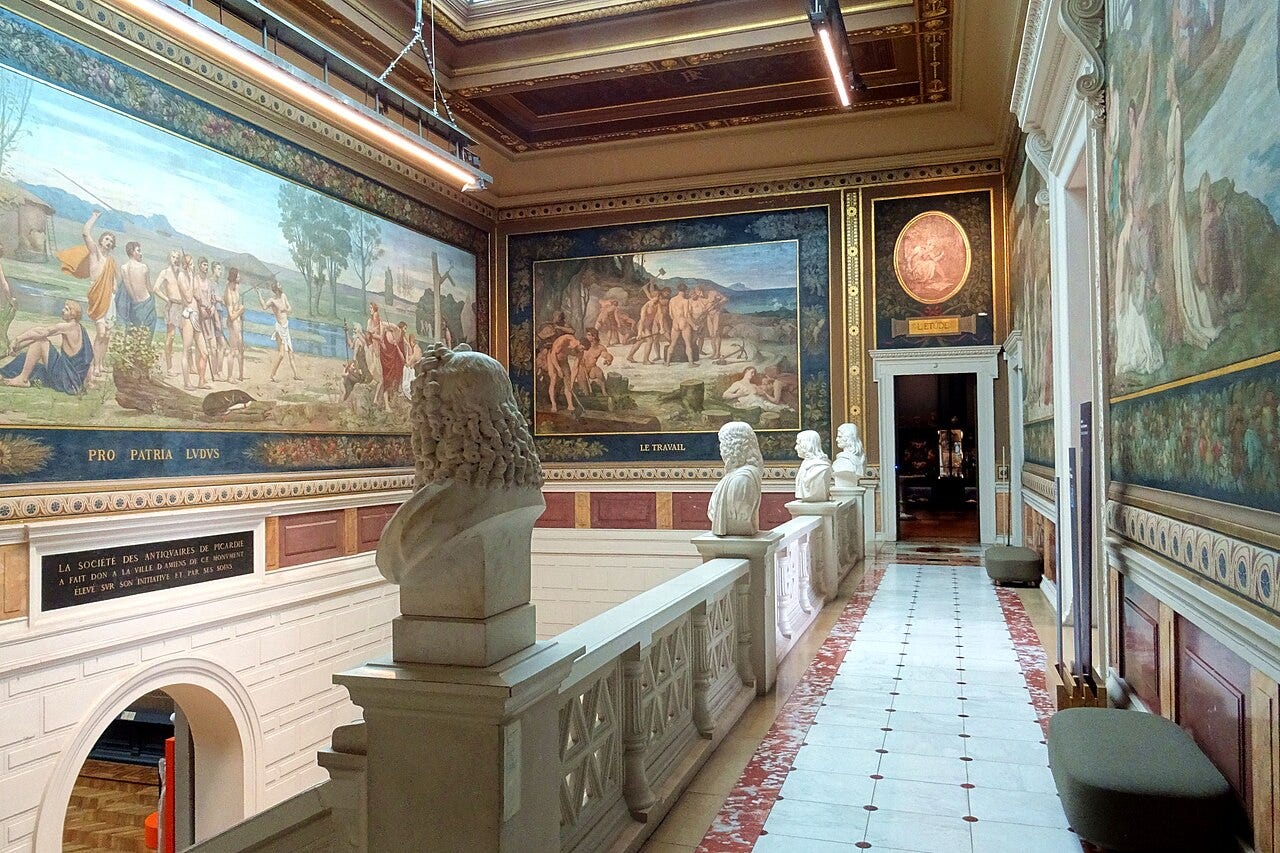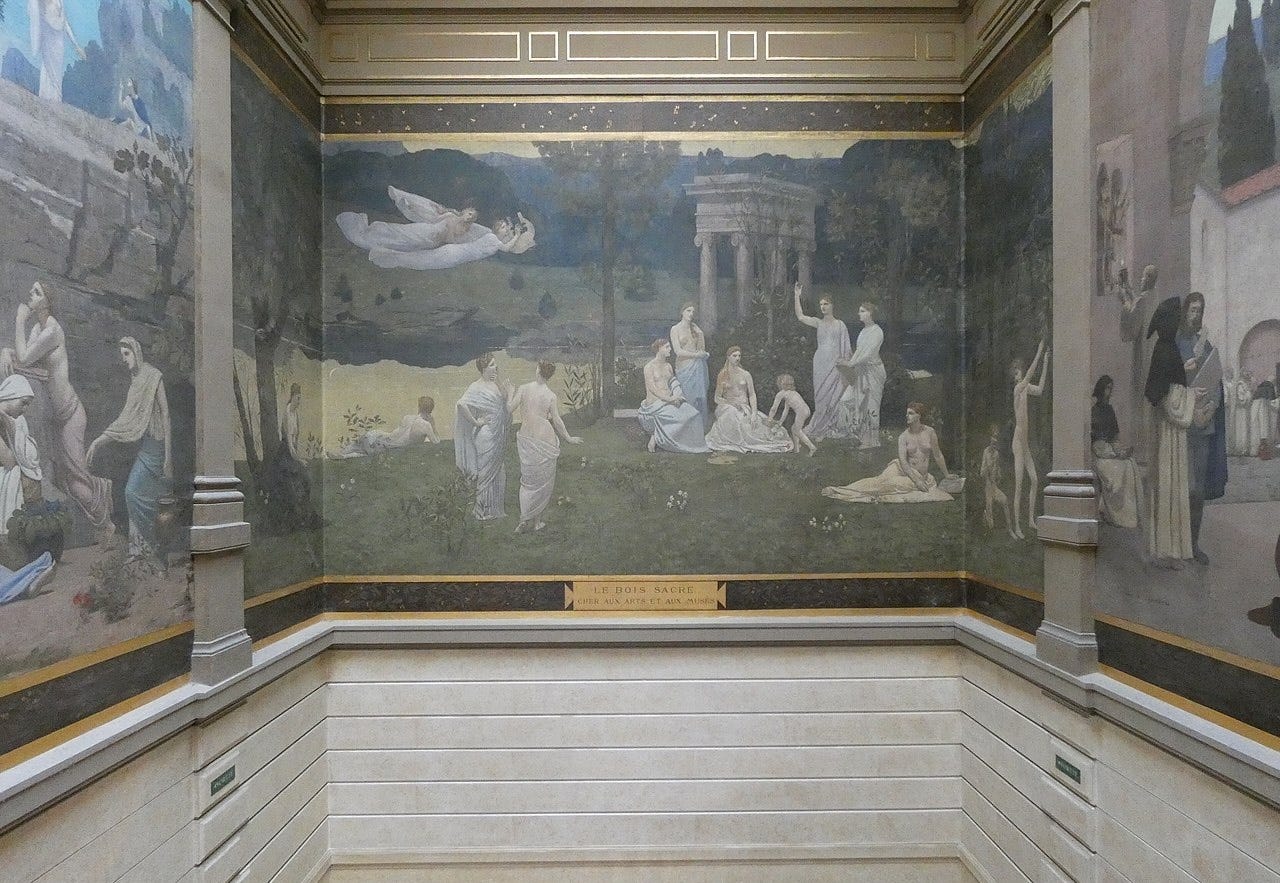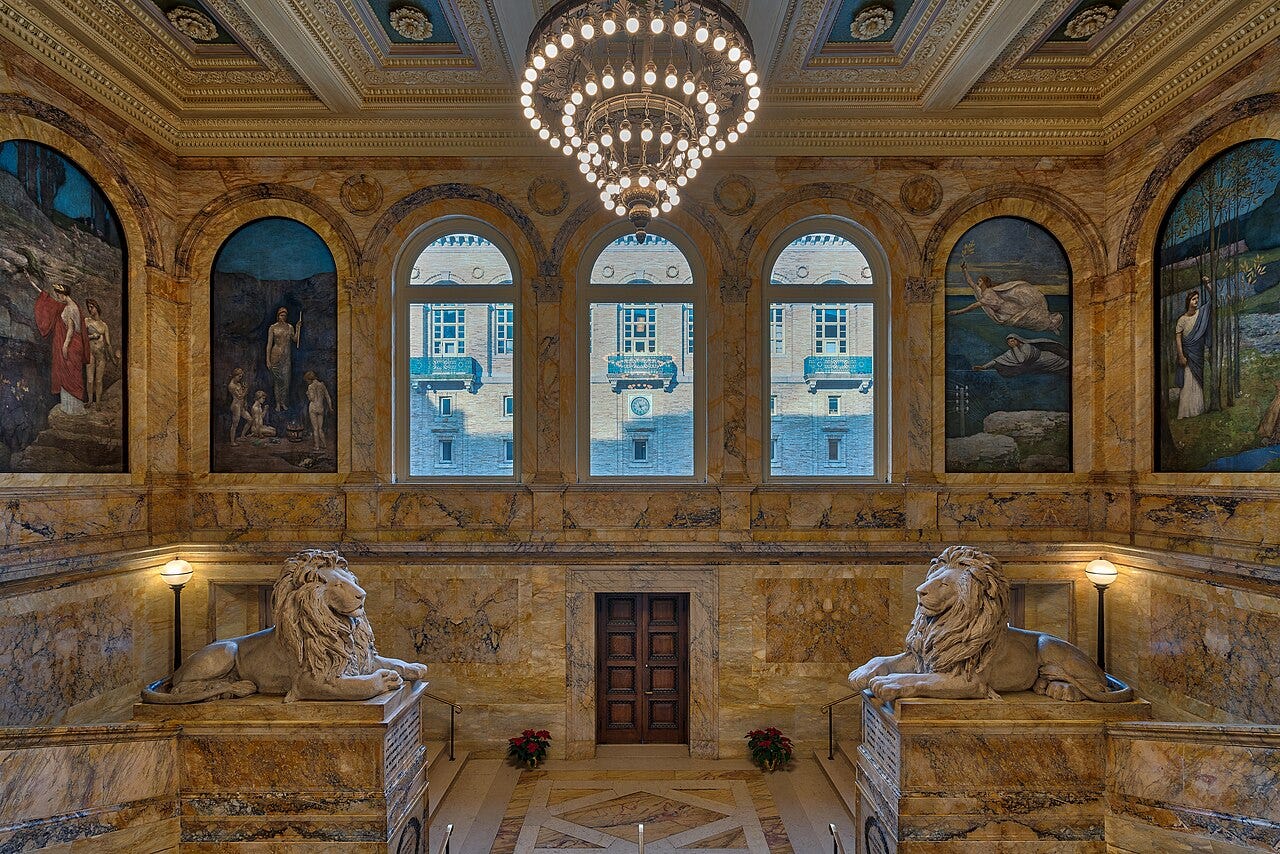Puvis de Chavannes, The Sacred Grove, 1884-1889

Pierre Puvis de Chavannes, the most renowned mural painter of the 19th century, was esteemed by both modern and traditional-minded camps in a deeply divided France, and beyond. How did he do it?
Painting for the Public
In an era when much modern painting was turning towards private and personal subject matter, Puvis stoutly continued to address the public as a whole, rendering great subjects of church and state for public buildings across France. Called France’s “greatest public painter,” Puvis’s murals “were imagined to embody a vision of France and to impart a sense of Frenchness.”
For the town hall of Poitiers, where Charles Martel’s Franks turned back the advance of the Umayyad Caliphate in a turning point of Western history, he created two murals from the hinge point between late antiquity and the early middle ages: one depicting Charles’s victory, and the other depicting the Frankish queen Radegund, founder of the local abbey, giving asylum to poets and preserving literature against the barbarity of the age.1
For the Panthéon in Paris, he created a cycle of the life of Saint Geneviève, the city’s patron saint.

For the Museum of Picardy in Amiens, he created a suite of murals on national and patriotic allegorical subjects, including War; Peace; Work; Rest; Patriotic Games; and Hail, Picardy, the Nourisher.

For the grand staircase in the Museum of Fine Arts in Lyon, he created a mural showing the nine muses and the three arts (painting, sculpture, and architecture) dwelling in a sacred grove (of which a smaller version, above, is in the Art Institute of Chicago.)2

For McKim, Mead, and White’s Renaissance Revival Boston Public Library, he created nine murals to surround the grand staircase: The Muses of Inspiration Hail the Spirit, the Harbinger of Light; Philosophy; Astronomy; History; Chemistry; Physics; Pastoral Poetry; Dramatic Poetry; and Epic Poetry.3

The Ideal and the Spiritual
As this set of works suggests, Puvis preserved a connection to the tradition of art that took ideal or spiritual realities seriously, swimming against the tide in an era when schools of realism and materialism cast doubt on these things. One critic wrote that “Puvis always made reference to a humanism and system of philosophy of a very traditional nature, which was outmoded for his time.”4 In the view of another:
Without being positively Christian his inspiration preserves a clearly spiritual character. In the midst of the materialistic invasion of the second half of the nineteenth century Puvis (with Eugène Carrière) was the noblest champion of religious art in France […] He upheld the rights of the ideal in the modern world, making it known and detaching it from dreams, art, and poetry. He always had an unshakable faith in the holiness of the spiritual side of humanity and in the supreme importance of continuous search, aspiration, and unrest which form the moral capital of our race. As an artist he did much to maintain religion among men.5
Puvis engaged with the ideal both through allegory (that is, representations of abstract ideas such as war, peace, work, and rest) and through classicism (that is, by using figures from ancient myth who evoke abstract ideals or themes).
Many modern viewers find allegory and classicism to be off-putting, because understanding such works requires a certain effort by the viewer to achieve familiarity with the references, either acquired in school or through one’s own efforts. But the degree of such effort can be exaggerated. Either a wall label or a quick Google search is usually enough to get the basic idea. And the reward is that such works, including those of Puvis, invite contemplation of broader and deeper realities, by comparison with strictly materialist or realist works that claim to only depict the concrete matter at hand.
Modernist painting: flatness and rhythm
With such an attachment to traditional aspects of art, Puvis nevertheless gained the respect of his modernizing peers. This was because his stylistic approach recognized the prevailing concern that academic art had come to seem artificial, and detached from reality. So, instead of a slick illusionism, Puvis’s style used the medium of painting in a way that modernists found satisfying.
Long before the twentieth-century art critic Clement Greenberg, and quite differently from Manet (who is usually cited as the keystone of modernism), Puvis’s work respected the essential two-dimensionality of painting. Figures are typically grouped together in a shallow field rather than shrinking into the distance. The landscape is likewise rendered as shallow, with the foreground emphasized, and a high horizon line limiting the visible depth.
Rather than being shown in intricate depth and detail, the figures are drawn in a simplified, “naive” manner, sometimes appearing stiff or distorted, as flat “cutouts.” The shapes of the figures, and their heavy contour lines, are all in the service of the overall two-dimensional composition, its “solemn and magnificent rhythm.” (Compare Matisse’s Dance for a more extreme, 20th-century version of this.)

In the words of one critic, “These figures whose gestures and steps are like a rhythm, whose physiognomy speaks of a rest that nothing can disturb, appear in this silent wood like visions in a dream.” For another, “Figures are treated first and last as part of the flat design, stripped of arresting detail to such an extent that the painter has been accused of ignorance of structure.” Another, Jules Castagnary, writing about Marseilles, Gateway to the Orient at the 1869 Paris Salon, complained that Puvis’s models were “painted with such a poor and inexperienced hand that their model does not reach the relief of a mantelpiece.”
Color and surface: a beautiful dream
Words like dream, reverie, and idyll are often used to describe Puvis’s work. These point to a certain stillness and serenity in the compositions. There is not much violent action, or conflict. They convey a certain timelessness. Both the human figures, and the natural environment in which they are embedded, seem at peace. If there is tension, it is a harmonious tension, not an unpleasant or dissonant one. If Puvis’s work is like a dream, it would be a kind of daydream or nocturne—definitely not a nightmare.
His muted color palette contributes to this mood. Tending not to use any colors that are too bright or intense, Puvis keeps the viewer’s eye calm with muted blues, greens, and grays. The “delicately harmonious” colors “caress the eye.”
To imitate the pale colors of fresco in his murals, Puvis painted in a very light key within a narrow tonal range, “renouncing all the effects of depth belonging properly to oil.” Puvis was accused in his own day of starting “a contagion of white.” Lead white was found as a major component in every layer of paint sampled at the Boston Public Library. Puvis kept the range of colors simple, limiting the number of pigments used in each work and using them consistently within each painting. He likely achieved this harmony in a process, described by his student Baudouin, of mixing large amounts of “mother tones” (tons mères) in bowls (assiettes creuses) that he kept submerged in water so that they would not dry out.6
And:
Puvis’s use of a limited palette of pastel tones had the effect of removing his paintings from the world of everyday reality and of intensifying their mythical and symbolic status. This distancing—deployed to brilliant effect in the Ste. Genevieve murals in the Pantheon—created a muted world seen to imitate the purity of Renaissance fresco paint ing. Whether they adored or detested these works, contemporaries were aware that Puvis’s paintings were radically different from the vividly colored realism which crowded the walls of the Salon.7
Along with the pale colors, Puvis achieved a matte, non-reflective surface that made people think of fresco painting (pigment in wet plaster), although he was working with oil on canvas. He used an absorbent layer of white chalk in glue; drained oil from his pigments by placing them on blotting paper; and did not use (shiny) varnish to finish his murals.
The dreamlike state created by the muted colors and matte surface conveys a sense of timelessness, reinforced by the “almost exclusive use of verticals and horizontals” in his composition (as opposed to dynamic diagonals).
Traditional Themes and Modern Means
The patriotic and religious aspects of Puvis’s work, his commitment to public murals, as well as his idealization and classicism, met with approval from the traditional and established elements of society. At the same time, his style, with its simplified figures and flattened compositions, its matte surfaces and muted colors, and its unified, rhythmic, decorative aesthetic, was of interest to the modernists. Few painters can have been able to hold all of these things together as well as he did.
Further Reading
Jennifer Laurie Shaw, Dream States: Puvis de Chavannes, Modernism, and the Fantasy of France.
L.C. “Studies for the Childhood of St. Genevieve. Puvis de Chavannes.” Bulletin of the Art Institute of Chicago.
Marie Royo, “Un musée dans l’Hôtel de Ville,” L’Actualité. Emil Zola, “Lettre de Paris (Le Salon de 1875),” Les Cahiers naturalistes.
“Le Bois sacré cher aux arts et aux muses,” MBA Lyon. “The Sacred Grove, Beloved of the Arts and the Muses,” Art Institute of Chicago.
“Puvis de Chavannes’s Allegorical Murals in the Boston Public Library,” Teri Hensick, Kate Olivier, & Gianfranco Pocobene, culturalheritage.org.
“Chavannes Gallery Murals The Muses of Inspiration Works by Pierre Puvis de Chavannes, installed 1895-1896,” bpl.org.
Marie-Christine Boucher, “Puvis de Chavannes, Pierre(-Cécile),” Grove Art Online.
Louis Gillet, “Pierre Puvis de Chavannes,” Catholic Encylopedia. Newadvent.org.
Ruth Harris, review of Aimee Brown Price, The Burlington Magazine.